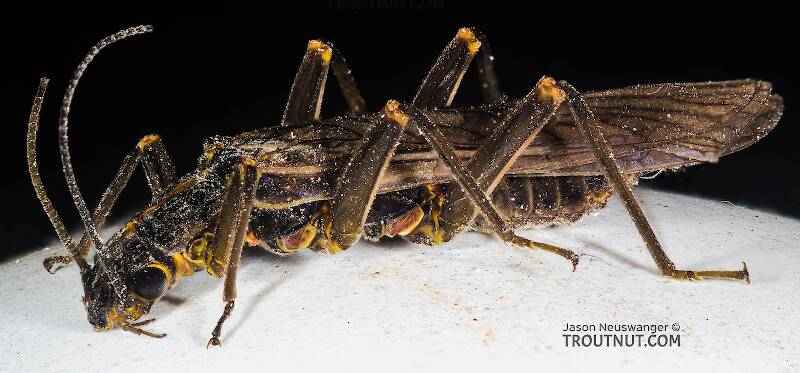
Blue-winged Olives
Baetis
Tiny Baetis mayflies are perhaps the most commonly encountered and imitated by anglers on all American trout streams due to their great abundance, widespread distribution, and trout-friendly emergence habits.
Featured on the forum

Troutnut is a project started in 2003 by salmonid ecologist Jason "Troutnut" Neuswanger to help anglers and
fly tyers unabashedly embrace the entomological side of the sport. Learn more about Troutnut or
support the project for an enhanced experience here.
Wwelz
Posts: 2
Posts: 2
Wwelz on Jun 26, 2008June 26th, 2008, 2:49 am EDT
I was fishing the Natchaug river a steam in eastern ct on June 23 from five pm till dark. I saw a couple of sulphurs size 18 on the water at six pm. As the evening went on the fish were acting like they were chasing nymphs to the surface sometimes leaping totally out of the water. They were also swirling for something right under the surface. I caught a few fish on a sulphur dry fly but lots of refusals. I never saw a dun emerge after six pm or any sign of any insect emerging. I tried many emerger patterns under the surface with no luck. whats going on here? Behavioral drift?
GONZO on Jun 26, 2008June 26th, 2008, 6:43 am EDT
Wwelz,
What you describe sounds very much like what happens when a strong caddisfly emergence coincides with a minor emergence of mayflies. Here are the italicized headings Gary LaFontaine uses in the section "Learning to Recognize a Caddisfly Emergence" in Caddisflies:
One, a trout occasionally leaps into the air.
Two, most of the feeding trout are bulging or splashing.
Three. There are no insects on the surface.
Although these signs do not apply to all caddisfly emergences (some do not emerge on the surface), and other activity could also be the cause, it is a good possibility that this is what you witnessed. Unlike many mayfly emergences, adult caddisflies often are not as obvious on the surface or in the air during an emergence. The times when we see large numbers of caddisflies flying about are usually during mating flights. Unless these coincide with an emergence, they typically have little to do with the feeding activity of trout until the females start laying eggs. (There are a few exceptions to this. For example, I often see trout leaping for the tightly clustered adults in black dancer [Mystacides] mating swarms.)
What I usually do when confronted with the situation you describe is to hold a pocket nymph seine at the surface in a strong line of drift. Sometimes emerging caddisflies are captured, but even when they are not, the filmy, transparent shucks left by emerging caddisflies often show up in the net.
What you describe sounds very much like what happens when a strong caddisfly emergence coincides with a minor emergence of mayflies. Here are the italicized headings Gary LaFontaine uses in the section "Learning to Recognize a Caddisfly Emergence" in Caddisflies:
One, a trout occasionally leaps into the air.
Two, most of the feeding trout are bulging or splashing.
Three. There are no insects on the surface.
Although these signs do not apply to all caddisfly emergences (some do not emerge on the surface), and other activity could also be the cause, it is a good possibility that this is what you witnessed. Unlike many mayfly emergences, adult caddisflies often are not as obvious on the surface or in the air during an emergence. The times when we see large numbers of caddisflies flying about are usually during mating flights. Unless these coincide with an emergence, they typically have little to do with the feeding activity of trout until the females start laying eggs. (There are a few exceptions to this. For example, I often see trout leaping for the tightly clustered adults in black dancer [Mystacides] mating swarms.)
What I usually do when confronted with the situation you describe is to hold a pocket nymph seine at the surface in a strong line of drift. Sometimes emerging caddisflies are captured, but even when they are not, the filmy, transparent shucks left by emerging caddisflies often show up in the net.
Wwelz
Posts: 2
Posts: 2
Wwelz on Jun 26, 2008June 26th, 2008, 9:54 am EDT
Thank you - I think you are right . I will try your suggestions
Quick Reply
Related Discussions
Topic
Replies
Last Reply
0
Mar 23, 2010
by Troutboomer
by Troutboomer
3
Oct 3, 2008
by GONZO
by GONZO
5
Jun 8, 2006
by Wiflyfisher
by Wiflyfisher
Re: Subsurface mayfly emergence: a conflicting account from one book
In General Discussion by Troutnut
In General Discussion by Troutnut
6
Oct 31, 2006
by Softhackle
by Softhackle


